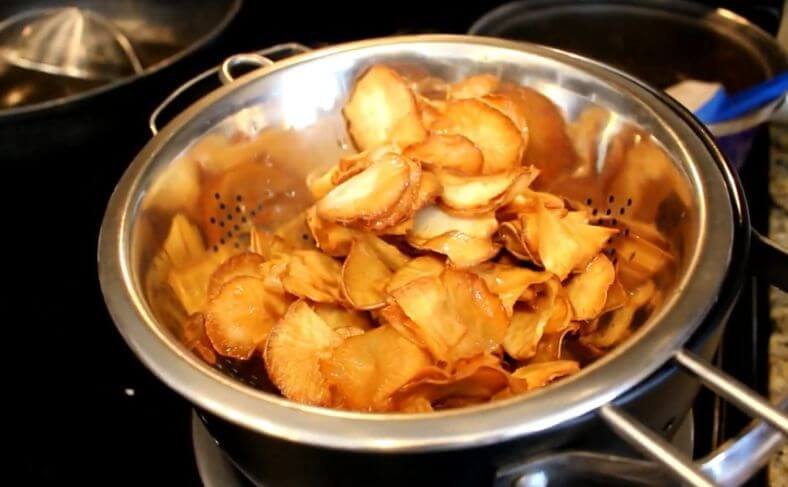Learn how to cook cassava root safely and deliciously. From boiling to frying, get step-by-step methods to turn this versatile root into a tasty dish.
Cooking cassava tubers requires the right techniques to bring out its best texture and flavor while ensuring safety.
This starchy tuber must be properly peeled, soaked, and cooked to remove toxins before use.
Whether you prefer boiling for a soft and tender bite, frying for a crispy treat, or baking for a rich, roasted flavor, each method offers a unique way to enjoy cassava.
From side dishes to snacks, mastering these cooking techniques allows for endless culinary possibilities.
This guide will teach you how to cook cassava root perfectly every time, through step-by-step methods, making it a delicious addition to your meals.
Related: 34 Benefits of the Cassava Tuber

Preparing Cassava Root for Cooking
Fresh cassava tuber from the cassava crop makes all the difference in taste and texture. Choose firm, unblemished roots and avoid any that feel soft or have mold spots.
Once you have good-quality cassava, proper peeling and cutting are the next steps.
Peeling and Cutting Cassava
Rinse the cassava under running water to remove dirt. Use a sharp knife to slice off both ends, then make a shallow cut along the length of the root.
Slide your knife under the thick brown skin and peel it away in sections, exposing the white flesh. Remove any dark spots.
Cut the cassava into six-inch sections, then split each piece lengthwise into halves or quarters for easier cooking.
Related: Recipes of Boiled Cassava Tuber
Soaking for Safety
Before cooking your cassava roots, you should soak them to remove the cyanide. Raw cassava contains cyanogenic compounds that can release toxins, so it’s important to soak the pieces in water for at least two hours.
This process helps remove harmful substances. After soaking, rinse the cassava thoroughly under running water.
Once prepared, your cassava is ready for cooking using different methods like boiling, frying, or baking.
Each technique brings out a unique texture and taste, giving you plenty of ways to enjoy this starchy root.
Related: How to Store Cassava Root
How to Cook Cassava Root: Different Methods We Use in Nigeria
While we love to process our cassava roots into garri and fufu, there are other ways it can be converted to food.
Each cooking method yields different results, allowing for a wide range of recipes.
Here, we explore five effective techniques: boiling, steaming, frying, roasting/baking, and making cassava porridge or paste.
Let’s take a closer look:
Recommended: Traditional Ways Cassava is Processed
Boiling Cassava

Boiling is one of the most common and simplest ways to cook cassava root. Place cut pieces in a large pot and cover them with water.
Bring to a boil over medium-high heat, adding a pinch of salt for enhanced flavor.
Let it simmer for about 20 to 30 minutes, or until the cassava becomes tender enough to be pierced with a fork.
Drain the water and serve hot with butter, olive oil, or a dipping sauce. Boiled cassava pairs well with grilled meats, stews, and vegetable sides.
To boost the flavor, try adding garlic, bay leaves, or coconut milk to the boiling water.
Related: How to Harvest Cassava Tuber the Right Way
Steaming Cassava

Steaming is a fantastic way to preserve cassava’s nutrients while maintaining its firm texture.
Place the pieces in a steamer basket over a pot of boiling water. Cover and let it steam for 25 to 30 minutes, or until soft but slightly firm to the touch.
Steamed cassava is excellent on its own but can be enhanced with a drizzle of lemon juice, fresh herbs, or coconut flakes.
It serves as a healthier alternative to boiling and pairs wonderfully with fish, roasted vegetables, or light sauces.
For extra richness, serve with a side of avocado or sprinkle with sea salt and olive oil.
Related: Cassava Tubers in Southeast Asian Cuisine
Frying Cassava

Fried cassava makes for a crispy, golden treat. After peeling and cutting the cassava into desired shapes, whether sticks for yuca fries, thin slices for chips, or thicker chunks, boil them for about 10 minutes to soften slightly.
Drain well and let them cool. Heat vegetable or coconut oil in a deep frying pan to around 350°F (175°C).
Fry the cassava pieces in batches, turning occasionally, until golden brown and crispy on the outside.
This usually takes about 5 to 7 minutes. Remove and drain on paper towels. Sprinkle with salt, chili powder, or herbs for extra flavor.
Serve hot with dips like garlic aioli, spicy ketchup, or cheese sauce. Alternatively, pan-fry cassava with butter for a lightly crispy texture and a rich, nutty taste.
Related: Cassava Tubers in the Caribbean
Roasting Cassava

Roasting cassava enhances its natural sweetness while giving it a slightly smoky flavor. Start by peeling and cutting the cassava into thick wedges or rounds.
Toss with olive oil, sea salt, and spices such as smoked paprika, cumin, or garlic powder.
Place the pieces on a grill or over an open flame, turning occasionally, until they develop a charred, crispy exterior.
This usually takes about 20 to 25 minutes. Roasted cassava is a great alternative to potato wedges and pairs well with grilled meats, barbecue dishes, or dipping sauces.
For an authentic experience, wrap whole cassava roots in foil and place them in hot embers for a slow-roasted, earthy taste.
Related: Healthy Cassava Root Recipes
Baking Cassava

Baking cassava delivers a crispy yet tender result, similar to oven-roasted potatoes. Peel and slice the cassava into thick wedges or cubes.
Boil for about 10 minutes to soften slightly, then drain and pat dry. Toss the pieces in olive oil and season with salt, black pepper, or your favorite herbs.
Spread evenly on a parchment-lined baking sheet and bake in a preheated oven at 400°F (200°C) for 25 to 30 minutes, flipping halfway through, until golden brown and crispy.
For extra crunch, broil for the last 3 to 5 minutes. Serve baked cassava as a side dish, seasoned with fresh herbs or a sprinkle of Parmesan cheese.
A drizzle of honey or garlic butter can also enhance the flavor.
Related: Can You Eat Raw Cassava Root?
Making Cassava Porridge or Paste

Cassava can also be prepared into a soft and creamy porridge, often enjoyed in many cultures. Start by peeling and grating fresh cassava.
Squeeze out any excess liquid, then mix the grated cassava with water or coconut milk.
Cook over low heat, stirring constantly, until it thickens into a smooth, creamy consistency. This takes about 10 to 15 minutes.
You can sweeten it with sugar, honey, or cinnamon for a breakfast dish or keep it savory by adding salt, butter, or nutmeg.
Cassava paste is often used as a base for other dishes and pairs well with soups, stews, or grilled proteins.
Suggested: How to Make Boba Using Cassava Roots
Tips to Bring Out the Best Flavor and Texture in Cassava
Knowing how to cook cassava root makes all the difference in taste and texture.
Whether you like it soft, crispy, or creamy, a few simple tricks can help you get the best results.
Use Seasonings That Add Depth
Cassava has a mild, starchy flavor that absorbs seasonings well. The right spices and herbs can turn it into a rich and satisfying dish:
- Garlic, onion, and ginger: Add a savory and aromatic depth. Use fresh or powdered versions when boiling, steaming, or frying.
- Cumin, paprika, and chili powder: Give a smoky or spicy kick, perfect for roasting or baking.
- Fresh herbs like cilantro, parsley, or basil: Sprinkle on top before serving for a burst of freshness.
- Coconut milk and lime juice: Create a creamy, slightly tangy twist when making mashed or boiled cassava.
Pair Cassava with the Right Foods
What you serve with cassava changes the entire meal experience:
- Protein pairings: Grilled chicken, fish, beef, or beans balance cassava’s starchiness.
- Vegetables for texture: Sautéed bell peppers, carrots, and green beans add crunch and color.
- Dipping sauces: A tangy lime vinaigrette, spicy tomato salsa, or garlic butter sauce makes every bite more exciting.
Store It Properly to Keep It Fresh
Cassava tastes best when eaten fresh, but if you have leftovers, here’s how to store them:
- Refrigerate in an airtight container: This keeps it fresh for up to three days.
- Freeze for long-term storage: Wrap cooked cassava tightly and freeze for up to three months.
- Reheat the right way: Steam or bake instead of microwaving to prevent a soggy texture.
Avoid These Common Mistakes when Cooking Cassava Root
Even small mistakes can ruin the texture and taste of cassava:
- Undercooking: Raw cassava is tough and contains toxins. Boil or steam until fully tender.
- Overcooking: Too much boiling or frying makes it fall apart or turn mushy.
- Not peeling properly: The outer skin and inner core should be removed to avoid a bitter taste.
When cooked correctly, cassava becomes a delicious addition to any meal. Try different seasonings and pairings to find your favorite way to enjoy it!
Related: How to Extract Native Starch from Cassava Tuber
Video of How to Cook Cassava Root
Frequently Asked Questions
Is cassava root safe to eat raw?
No, raw cassava contains cyanogenic compounds that release toxins. Always peel, soak, and cook thoroughly to ensure it’s safe for consumption.
What’s the best way to cook cassava for a soft texture?
Boiling is best for a soft texture. Simmer cassava in salted water for 20–30 minutes until tender, then drain and serve.
How do I make cassava crispy?
Frying or baking works best. Boil first, drain well, then fry in hot oil or bake at 400°F until golden brown.
Can I store cooked cassava?
Yes, refrigerate in an airtight container for three days or freeze for up to three months. Reheat by steaming or baking.
Conclusion
Knowing how to cook cassava root properly gets the best out of it to suit different tastes and textures.
Whether you prefer it boiled for a tender bite, fried for a crispy snack, or baked for a healthier option, proper preparation ensures safety and flavor.
Soaking removes harmful compounds, while cooking techniques like seasoning and pairing with the right dishes enhance its taste.
With the right approach, cassava can be an exciting addition to your meals.
Experiment with different methods and flavors to discover your favorite way to enjoy this nutritious root vegetable.

Chimeremeze Emeh is a writer and researcher passionate about Africa’s most transformative root crop—cassava. Through his work at cassavavaluechain.com, he explores the entire cassava industry, from cultivation and processing to its diverse applications in food, health, and industrial use.
He also writes for palmoilpalm.com, where he shares his extensive experience and deep-rooted knowledge of palm oil, covering red palm oil, palm kernel oil, and refined products. His work there reflects his lifelong connection to agriculture and his commitment to promoting sustainable value chains in Africa.
Driven by curiosity and purpose, Chimeremeze aims to shed light on how cassava continues to empower communities, strengthen food systems, and link traditional farming wisdom with modern innovation.

